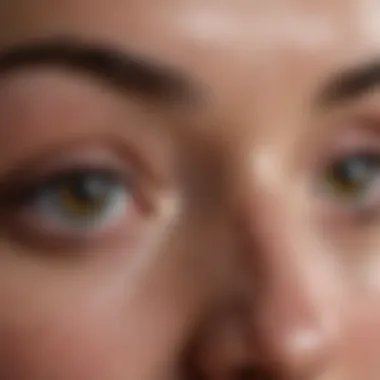Understanding the Causes and Remedies for Dark Circles


Intro
Dark circles under the eyes are a cosmetic issue that many people encounter. The appearance of these dark circles can be attributed to various factors, both internal and external. Among the internal factors, genetics plays a significant role, while lifestyle choices can also influence their development. A poor diet, lack of sleep, and stress can all worsen the periorbital darkening.
Often, dark circles are mistakenly seen as merely a lack of sleep or fatigue. However, this condition reflects a broader picture of health and wellness. Taking a holitistic view allows one to assess and address the problem more effectively. In this article, we will closely examine the different causes behind dark circles and present remedies that can help mitigate their appearance.
By the end of this piece, health professionals and wellness coaches will gain deeper insights into why dark circles may develop, plus effective methods to manage them. We aim to provide a comprehensive guide that will empower individuals to tackle this common concern thoughtfully.
Next, we will explore potential remedies that can yield positive results.
Intro to Dark Circles
Dark circles under the eyes represent more than just a cosmetic inconvenience. They are often indicative of underlying health issues, lifestyle habits, or genetic predispositions. In this article, we will delve into the multifaceted nature of dark circles, providing a comprehensive understanding of what they are and why they occur. Addressing this issue is important for enhancing a person's overall appearance and boosting self-esteem. By understanding the root causes, individuals can take informed steps toward remedying this concern.
Defining Dark Circles
Dark circles, commonly referred to as periorbital dark circles, appear as discoloration under the eyes. This condition is characterized by a bluish or purplish hue that can create an impression of fatigue or aging. The skin under the eyes is notably thin, making underlying blood vessels more visible when they become dilated or congested. Various factors contribute to the formation of these circles, which can be both temporary and chronic.
"Effective identification of the cause of dark circles is crucial for determining the appropriate course of treatment."
Chronic dark circles may arise from genetic factors, such as family history or skin pigmentation. Temporary variations could stem from lack of sleep, stress, or dehydration. Understanding the specific characteristics of dark circles helps in discerning the most effective strategies for treatment.
Dark circles are relevant in various fields, including dermatology, nutrition, and wellness coaching. Professionals in these areas may observe that managing this condition can involve a combination of lifestyle modifications, dietary improvements, and, in some cases, medical interventions. Recognizing dark circles as a symptom rather than merely an aesthetic issue allows for a more holistic approach to care and remedy.
In the following sections, we will explore the potential causes of dark circles, their impact on individuals, and various effective remedies.
Potential Causes of Dark Circles
Dark circles under the eyes often reflect underlying health issues or lifestyle choices. Understanding the causes is crucial for selecting effective remedies. In this section, we will explore several potential factors contributing to this common concern. Recognizing these causes can guide individuals in adopting necessary changes to improve the appearance of their skin.
Genetic Factors
Genetics plays a significant role in the formation of dark circles. Individuals may inherit specific traits from their parents, such as thinner skin or pigmentation patterns. If a family has a history of dark circles, it is likely that the younger members will also encounter this issue. This biological predisposition means that some people are structurally more prone to having dark circles, regardless of lifestyle choices.
Skin Structure and Aging
As people age, their skin undergoes various changes. The outer layer of skin, known as the epidermis, becomes thinner. This process is often exacerbated by the loss of fat and collagen. Consequently, blood vessels beneath the skin can become more visible, creating a shadowy effect that manifests as dark circles. Aging also affects how well the skin retains moisture, leading to a dull appearance that can make dark circles more prominent.
Lifestyle Choices
Lifestyle habits significantly influence the presence of dark circles. Poor sleep quality is a key factor. Insufficient rest can dull the skin and intensify the visibility of dark circles. Similarly, excessive alcohol consumption and smoking lead to dehydration, promoting a tired look. Both habits can deplete essential nutrients from the skin, worsening the situation. Regular physical activity is beneficial too. It boosts circulation and may help mitigate dark circles over time.
Dietary Deficiencies
Diet has a strong connection to skin health. Insufficient intake of vitamins and minerals can lead to darker circles under the eyes. Deficiencies in Vitamin K, Vitamin C, and iron can intensify the appearance of dark circles. Iron deficiency, particularly, leads to poor oxygenation of the blood, resulting in a dull complexion. Including a variety of fruits, vegetables, and whole grains in your diet can help combat these deficiencies.
Medical Conditions
Several medical conditions can lead to dark circles. Allergies, for instance, can cause nasal congestion, leading to increased blood flow around the eyes. This can give a darker appearance under the eyes. Other conditions, such as eczema or dermatitis, may result in skin irritation or inflammation. Moreover, chronic illnesses, like kidney or liver problems, can also manifest physical symptoms, including dark circles. A healthcare professional should evaluate persistent or unusual changes to skin appearance for proper guidance.
"Understanding the various factors of dark circles under the eyes empowers individuals to take actionable steps in improving their skin health."


In summary, dark circles can arise from a combination of genetic, structural, lifestyle, dietary, and health-related factors. By identifying these potential causes, individuals can adopt targeted strategies to reduce their appearance.
Impact of Lifestyle on Dark Circles
The influence of lifestyle on the appearance of dark circles cannot be underestimated. Our daily choices shape our overall well-being and are closely linked to various skin conditions. Dark circles particularly reflect the cumulative effects of sleep deprivation, stress, and other habits on skin health. Understanding this can pave the way for effective strategies to reduce their visibility.
Sleep Patterns
Sleep is vital for the body. A lack of adequate rest leads to tired-looking eyes. Forgoing sleep results in the dilation of blood vessels under the eyes. This can cause a shadowy effect, enhancing the appearance of dark circles.
To minimize dark circles, it is crucial to establish a healthy sleep routine. Aiming for seven to nine hours of quality sleep each night can significantly improve the skin's appearance. Moreover, keeping a consistent sleep schedule helps regulate the body's internal clock.
Stress Management
Stress plays a pivotal role in skin conditions, including dark circles. High-stress levels trigger the release of cortisol, a hormone that can lead to inflammation and exacerbate dark circles. Identifying stressors and implementing coping strategies is key.
Regular practice of mindfulness techniques, like meditation or deep breathing, can reduce stress. Engaging in physical activity also offers benefits by promoting relaxation and better overall health. A balanced mindset translates to healthier skin.
Screen Time and Eye Strain
Today’s digital age increases our screen exposure. Prolonged screen time can lead to digital eye strain, manifesting as fatigue and discomfort. This strain can cause blood vessels under the eyes to swell, resulting in dark circles.
To combat this, take regular breaks using the 20-20-20 rule: every 20 minutes, look at something 20 feet away for at least 20 seconds. Additionally, adjusting screen brightness and reducing glare can lessen eye fatigue.
Maintaining a healthy lifestyle is not merely about physical health, it significantly impacts skin aesthetics as well.
Diet's Role in Skin Health
Diet plays a crucial role in skin health, influencing not just the appearance of the skin but also its overall functioning. The skin, being the body's largest organ, requires specific nutrients to maintain its elasticity, hydration, and vitality. A well-balanced diet can mitigate conditions like dark circles under the eyes, providing a preventive measure against this common cosmetic concern. The focus here is on how essential nutrients and proper hydration contribute to a healthier and more radiant complexion.
Essential Nutrients
Nutrients vital for skin health include vitamins, minerals, and antioxidants. Each plays a unique role in promoting skin resilience against aging and fatigue.
- Vitamins: Vitamin C is essential for collagen production, aiding in skin firmness and reducing dark circles. Vitamin E serves as an antioxidant, protecting skin cells from damage caused by free radicals. B vitamins, particularly B12 and B6, also support skin regeneration.
- Minerals: Zinc is crucial for skin repair and helps with inflammation, which can aggravate dark circles. Selenium provides protection from oxidative stress, further maintaining skin health.
- Antioxidants: Foods high in antioxidants, such as berries, nuts, and green leafy vegetables, enhance skin texture and tone. They combat oxidative stress that can lead to premature aging.
Incorporating these nutrients into daily meals can make a significant impact. For example, consuming a varied diet rich in fruits, vegetables, lean proteins, and whole grains ensures that the skin receives the essential support it needs. Such dietary habits not only enhance skin appearance but also promote overall health.
Hydration and Skin Health
Hydration is another critical element affecting skin health. The skin's moisture levels are directly linked to its elasticity and clarity. Dehydration can lead to a dull complexion and accentuate dark circles. Therefore, maintaining proper hydration can yield visible benefits.
- Water Intake: Adequate water consumption supports overall bodily functions and keeps skin plump and hydrated. The general recommendation is about 8 glasses a day, but individual needs may vary based on activity levels and climate.
- Hydrating Foods: Eating fruits and vegetables with high water content, such as cucumbers, watermelon, and oranges, can also aid in skin hydration.
- Avoiding Dehydrating Substances: Reducing intake of caffeinated drinks and alcohol is important, as these can lead to dehydration. Opting for herbal teas or natural juices can be beneficial.
Ultimately, understanding the relationship between diet and skin health is fundamental for those concerned with dark circles. Being mindful of dietary choices can lead to significant improvements in skin appearance, contributing to a more refreshed and youthful look.
Common Misconceptions
Understanding common misconceptions about dark circles is essential. These false beliefs can lead to ineffective treatments and persistent frustration. To address dark circles effectively, one must sift through misinformation to grasp what truly contributes to this condition. It is important to consider the nature of dark circles and how various factors interplay in their appearance.
Caffeine Effects


Caffeine is often touted as a remedy for dark circles. Many creams and serums include caffeine, claiming that it reduces puffiness and dark coloration due to its vasoconstrictive properties. While caffeine can temporarily tighten blood vessels and diminish swelling, it is not a definitive solution to the underlying causes of dark circles. The effectiveness of caffeine largely depends on the individual’s skin type and the depth of the discoloration.
Research suggests that, for some, the beneficial effects may be minimal or short-lived. Relying solely on caffeine-based products can mislead individuals into neglecting more significant underlying problems such as sleep deprivation or dietary deficits. Therefore, caffeine may provide a temporary aesthetic solution, but it should not replace holistic approaches to skin health.
The Role of Makeup
Makeup plays a crucial role in how dark circles are perceived. Many use concealers to mask dark circles, enhancing appearance in the short term. However, makeup is merely a cosmetic tool and does not address the root issue.
It’s vital to recognize that some ingredients in makeup can irritate the skin under the eyes. Products with heavy formulations can emphasize dark circles or cause further irritation, leading to a cycle of dependency on makeup. Understanding when and how to use makeup can aid in enhancing appearance, but it should be combined with effective skincare practices for lasting results.
"Permanent change in the appearance of dark circles requires a nuanced understanding of lifestyle and health, not just topical fixes."
To truly combat dark circles effectively, one must adopt a comprehensive strategy that includes examining lifestyle, ensuring sufficient rest, and maintaining nutritional balance.
Natural Remedies for Dark Circles
Dark circles under the eyes can be bothersome, impacting one’s appearance and sometimes even self-esteem. Natural remedies offer a gentle approach to alleviate this condition. They typically come with fewer side effects than medical treatments. Many remedies can be carried out using simple household items or easily accessible ingredients. Emphasizing natural methods allows individuals to integrate these solutions into their daily routine with minimal effort.
The importance of exploring these remedies lies in their accessibility and safety. They can often address underlying issues such as dehydration or lack of sleep without the need for expensive treatments or products. By understanding and implementing these strategies, individuals can tackle dark circles effectively.
Cold Compresses
Cold compresses are a straightforward yet effective remedy for reducing dark circles. The cold helps constrict blood vessels and decrease swelling. This remedy is particularly beneficial when dark circles are caused by fluid retention or fatigue.
To apply a cold compress, you can use:
- A clean washcloth soaked in cold water.
- Ice wrapped in a soft cloth.
- Chilled cucumber slices, which also offer a soothing effect.
Apply the compress to the affected area for about 10 to 15 minutes. This method not only helps in diminishing dark circles but also imparts a refreshing sensation, making it ideal for mornings or after long days.
Hydrating Agents
Keeping the skin around the eyes well-hydrated can significantly help with the appearance of dark circles. The skin in this area is thin and delicate, requiring extra care. Using hydrating agents ensures that the skin retains moisture, which can improve its texture and tone.
Consider these hydrating substances:
- Aloe vera gel: Known for its soothing and moisturizing properties. Apply a small amount gently under the eyes at bedtime.
- Coconut oil: With its natural fatty acids, this oil can deeply nourish the skin. Massage a tiny amount around the eyes using your ring finger.
- Glycerin: Often used in skincare, glycerin is excellent for attracting moisture. Look for eye creams containing this ingredient.
Regular application of these hydrating agents can help to diminish the visibility of dark circles over time.
Herbal Remedies
Herbs have long been used for their therapeutic properties. Various herbal remedies can be beneficial in combating dark circles. They often provide additional vitamins and nutrients that promote overall skin health.
Some effective herbal options include:
- Chamomile Tea Bags: After steeping and cooling, use the bags on your eyes for about 15 minutes. Chamomile has anti-inflammatory properties that help reduce puffiness and dark coloration.
- Rose Water: Known for its soothing properties, rose water can be applied directly to the skin or soaked in cotton pads and placed over the eyes. It helps in hydration and rejuvenation of the skin.
- Green Tea: Similar to chamomile, green tea can be brewed and cooled, then applied using tea bags. It contains antioxidants that can help in diminishing dark circles and improving the skin's overall appearance.
Incorporating these herbal remedies into your skincare routine can enhance the effectiveness while providing a holistic approach to care.
Medical Treatments for Dark Circles
Medical treatments for dark circles are essential to consider for those seeking a more efficient resolution. These interventions are generally targeted at providing visible improvements and address the root causes of dark circles. Unlike home remedies, which can vary in effectiveness, medical options often present more reliable outcomes through professional assessment and targeted solutions. Treatment plans can also be tailored to each individual, depending on their unique skin characteristics and underlying issues.


Topical Creams
Topical creams are among the first lines of defense against dark circles. They often contain active ingredients like caffeine, retinol, peptides, and vitamin C. Caffeine works by constricting blood vessels, which can help reduce the bluish tint of dark circles. Retinol promotes cell turnover, aiding in skin renewal, while vitamin C brightens the skin, providing a fresh appearance.
Choosing the right cream requires an understanding of one's skin type. For sensitive skins, options that avoid harsh chemicals and fragrances are preferable. Application should be done gently, using the ring finger to tap the product around the eye area, minimizing further irritation.
Laser Treatments
Laser treatments provide a more invasive yet effective option for dark circles. These procedures employ focused light beams to target pigment and fine blood vessels, effectively lightening the under-eye area. Treatments like fractional laser and intense pulsed light (IPL) have shown promising results in clinical studies.
Patients should note that a series of sessions may be necessary for optimum results. There is also consideration of recovery time, as some redness or swelling may occur immediately after treatment. Consulting a dermatologist is crucial to evaluate the appropriateness of these procedures based on skin type and sensitivity.
Fillers and Injections
Fillers, primarily hyaluronic acid-based, are becoming increasingly popular for under-eye treatment. These injectables can add volume to hollows that contribute to the appearance of dark circles. With age or genetic predisposition, the skin under the eyes may lose fat, causing shadows, which can mimic dark circles. Fillers can provide a more youthful look by restoring lost volume.
Injections require precision; hence, only qualified medical professionals should perform them. The results can last from six months up to a year, but maintenance treatments will be necessary.
"Medical treatments often provide solutions that can’t be achieved through home remedies alone. Knowledge and professional guidance are key in achieving lasting outcomes."
Prevention Strategies
Preventing dark circles under the eyes is an essential aspect of maintaining overall eye health and appearance. Implementing effective prevention strategies can significantly reduce the appearance of dark circles and promote healthier skin. Understanding these strategies is vital for anyone who wants to tackle this concern before it becomes more pronounced. The key elements include achieving healthy sleep habits and maintaining a balanced diet, both of which are pivotal in combating the factors that contribute to dark circles.
Healthy Sleep Habits
Maintaining consistent and quality sleep patterns is crucial for reducing dark circles. Lack of sleep can lead to pallor and dull skin, making blood vessels more visible under the thin skin around the eyes. Aiming for 7 to 9 hours of sleep per night can aid in rejuvenation and repair, allowing skin to recover and restore its natural glow.
Here are some practices to promote healthy sleep habits:
- Establish a Routine: Going to bed and waking up at the same time daily, even on weekends, reinforces your body's natural sleep-wake cycle.
- Create a Relaxing Environment: Ensure your sleep space is cool, dark, and quiet to foster restful sleep.
- Limit Screen Time Before Bed: Reduce exposure to screens that emit blue light, which can interfere with melatonin production.
- Practice Relaxation Techniques: Engagement in activities such as deep breathing, meditation, or gentle yoga can calm the mind and prepare the body for restful sleep.
“Sleep is the best meditation.” - Dalai Lama
By focusing on these habits, individual can experience better rest, ultimately reducing the emergence of dark circles.
Balanced Diet Recommendations
A balanced diet plays a pivotal role in skin health and can contribute to preventing dark circles. Nutritional deficiencies can affect skin hydration and elasticity, making it more prone to dark circles. Integrating specific nutrients into daily meals not only benefits general health but also enhances skin appearance.
Consider the following dietary tips:
- Hydration: Drink an adequate amount of water daily. Proper hydration keeps skin plump and healthy.
- Antioxidant-Rich Foods: Incorporate fruits and vegetables like berries, spinach, and carrots. These foods help fight oxidative stress, improving skin appearance.
- Vitamin K and C Sources: Foods such as leafy greens and citrus fruits are essential. Vitamin K helps with blood circulation, while Vitamin C supports collagen production and skin repair.
- Healthy Fats: Include sources like avocados and nuts, which provide necessary fatty acids for skin moisture and elasticity.
By adopting these balanced diet recommendations, one can support skin health while deterring the formation of dark circles. Addressing these foundational aspects of sleep and nutrition can lead to substantial improvements in skin appearance, ultimately leading to a brighter, more refreshed look.
End
In summation, acknowledging the causes and remedies for dark circles under the eyes is crucial for those striving to maintain a healthy appearance. This article has provided thorough insights into the various factors that contribute to the appearance of these dark circles. Understanding both intrinsic and extrinsic elements allows individuals to address the concern more effectively.
Summary of Key Points
The key points outlined throughout the article include:
- Genetic Factors: One's genetic predisposition can influence the likelihood of developing dark circles.
- Skin Structure and Aging: As skin ages, it becomes thinner, making dark circles more visible.
- Lifestyle Choices: Poor sleep, high-stress levels, and excessive screen time are significant contributors.
- Dietary Deficiencies: Lack of essential vitamins and hydration can also exacerbate the issue.
- Medical Conditions: Certain health conditions may present or worsen the appearance of dark circles.
- Natural Remedies: Home-based treatments like cold compresses, various hydrating agents, and herbal remedies can offer relief.
- Medical Treatments: Options such as topical creams, laser treatments, and injectable fillers can serve as clinical approaches for persistent dark circles.
- Prevention Strategies: Establishing healthy sleep habits and maintaining a balanced diet can be effective preventive measures.
By synthesizing these elements, it becomes evident that a multifaceted approach is essential for managing dark circles. For health professionals, wellness coaches, and others in the field, this understanding facilitates better guidance for individuals seeking to improve their appearance and skin health. Taking proactive steps in lifestyle management and applying suitable remedies can lead to significant improvements. Embracing this knowledge is a vital part of caring for one’s skin.







